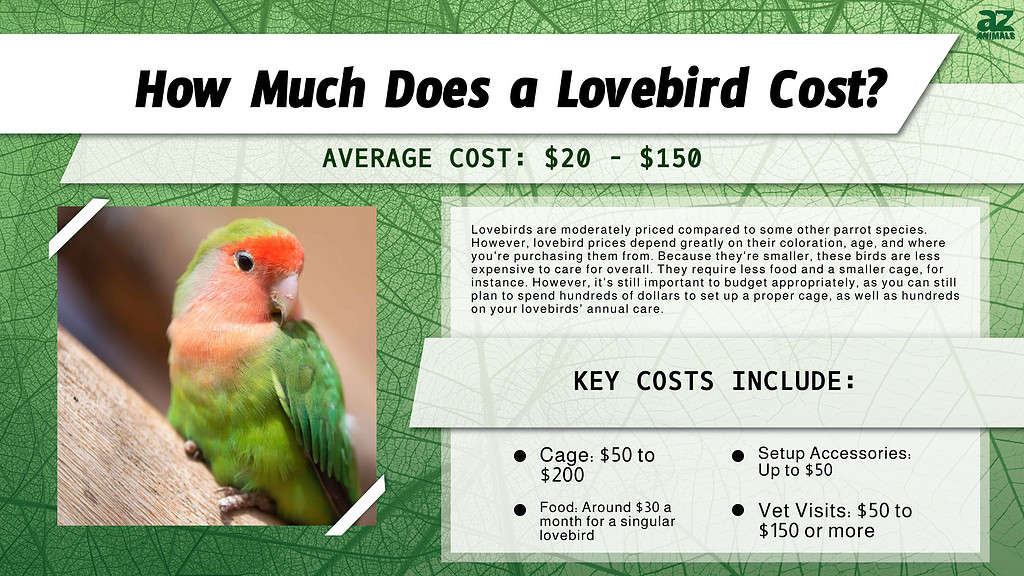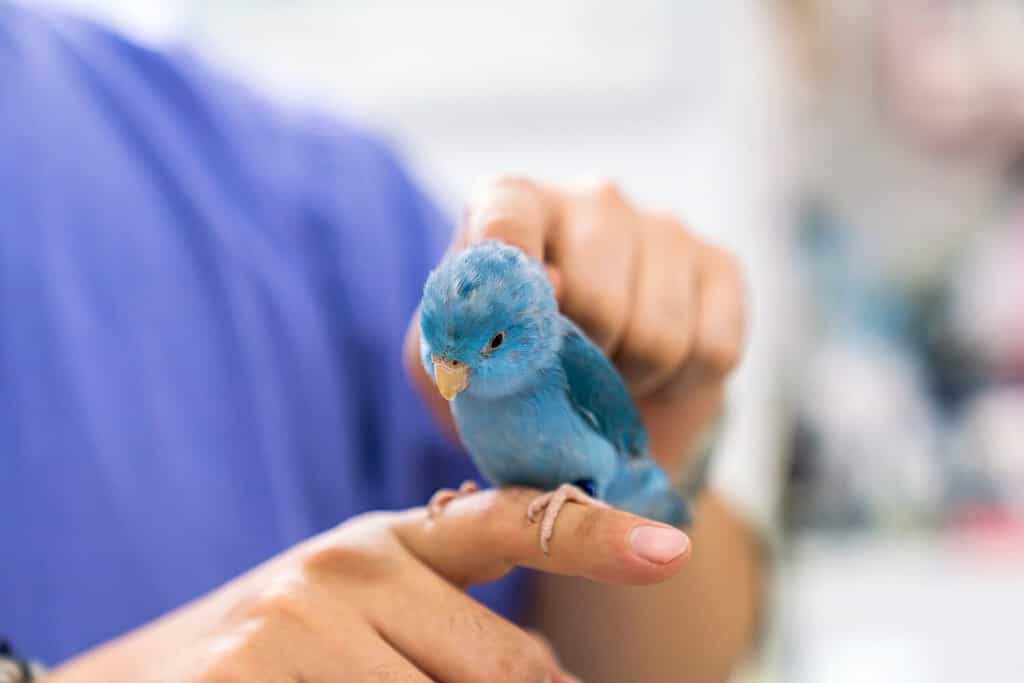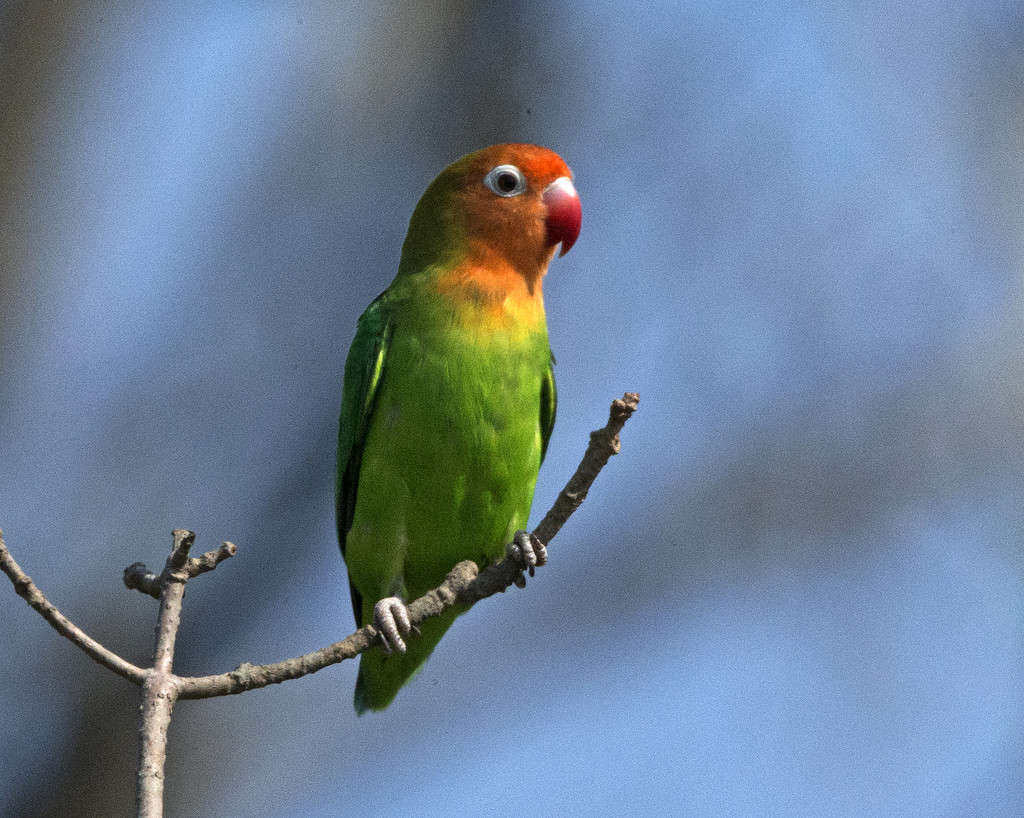Lovebirds are moderately priced compared to some other parrot species. However, lovebird prices depend greatly on their coloration, age, and where you’re purchasing them from.
Because they’re smaller, these birds are less expensive to care for overall. They require less food and a smaller cage, for instance. However, it’s still important to budget appropriately, as you can still plan to spend hundreds of dollars to set up a proper cage, as well as hundreds on your lovebirds’ annual care.
They’re cheaper than most birds, but that doesn’t make them free!
In this article, we’ll take a look at everything you need to know about these lovebirds, including their startup costs and monthly expenses.
Initial Lovebird Prices

When you first decide to bring your lovebird home, there are several things you’ll need to purchase. Of course, the price of the bride itself is at the top of most people’s minds. You’ll probably want to purchase more than one bird, as lovebirds are extremely social and do best with a friend.
Of course, purchasing two or more birds will raise the overall price. Generally, you can expect to spend $20 to $150 or more. There are several color mutations that lovebirds come in, each with its own characteristics. Some are more expensive than others. It often depends on how rare the bird is.
Younger, hand-fed birds are generally more expensive because they are tamer and easier to socialize. Older birds might be more affordable but could require more time and effort to bond with.
Where you purchase the bird also matters. If you’re purchasing from a breeder, you can expect to spend more money. However, breeders often produce more socialized birds, which can be easier to handle.
Cage
On top of the price of the bird, you’ll also have to purchase a cage. The price of a cage can vary widely, depending on the size and accessories it comes with. Often, a cage will cost anywhere from $50 to $200.
Lovebirds are often playful and enjoy having plenty of space to move around. Therefore, the cage should be large enough to accommodate this behavior. A minimum cage size for a single lovebird is around 18x18x18 inches, but larger is always better. For a pair of lovebirds, the cage should be even larger.
Cages without extra accessories may cost less, but this means you will have to purchase the accessories separately. Often, these cages aren’t less expensive unless you already have accessories at home.
Accessories
Speaking of accessories, several are needed for your lovebird’s health. For instance, every bird needs perches, toys, and dishes. These may come with the cage itself, but you can also purchase them separately. Even the most expensive cages usually don’t come with everything you need.
Perches are absolutely necessary and should be in different sizes to promote foot health. Natural wood perches are a great option, as they have varying thicknesses along the whole perch.
Lovebirds are intelligent, like most avians, so they need toys, too. You’ll probably spend quite a bit of money on toys – sometimes up to $50 initially (and then more monthly after that). Birds often do best when you rotate between toys, as this keeps things interesting.
Food
You’ll also need to purchase food for your lovebird. Food will probably be the most significant ongoing expense, and your birds absolutely cannot live without it. You can plan to spend around $30 a month on food for a singular lovebird.
We recommend pellets for the base of your lovebird’s food. These pellets are designed explicitly for lovebirds and contain all the nutrients your bird needs. They tend to offer a more complete diet than other options.
You can also offer a range of treats, including fresh fruits and veggies. However, a pelleted diet should make up the bulk of your bird’s calories.
Veterinary Care

Lovebirds require regular veterinary care to help them remain healthy and happy.
©thirawatana phaisalratana/Shutterstock.com
All lovebirds need some amount of preventative care. You should get your birds regular check-ups with an avian veterinarian, which can cost a couple hundred dollars a year. These preventative appointments help detect illnesses early and even prevent expensive conditions.
On top of preventative care, your lovebird may also need emergency vet services. If your bird gets sick or injured, a vet visit is often required. This can potentially cost thousands of dollars, depending on the condition. Of course, you cannot predict when your bird will get sick.
Therefore, it is best to have an emergency fund to pay for these surprise expenses if necessary.
Bedding and Cleaning Supplies
Keeping your bird’s cage clean and comfortable is a huge part of taking care of your lovebirds. These birds will spend much of their time inside their cage, so it’s important that their cage is a safe, clean place for them to live.
You’ll need to line the bottom of the cage with a proper cage liner or bedding material. Many lovebird owners use newspapers, paper towels, or specialized cage liners for this purpose. These liners cage droppings and food debris, making cleanup much easier. You should change these liners daily.
Luckily, if you use recycled newspaper or paper towels, these liners shouldn’t be expensive at all.
Some owners use a bedding material to help control messes (either instead of or on top of the liner). However, many commercial beddings are not safe for birds, so you’ll need to be careful. Paper-based bedding or natural materials like aspen shavings work best. Avoid cedar or pine bedding, as these can be harmful to birds.
You’ll also need to purchase a cleaning solution that is safe for your bird. You don’t necessarily need to purchase one that is specifically designed for birds, but you will need some sort of gentle cleanser. Avoid using strong household cleaning chemicals or aerosols around your lovebirds. Birds are sensitive to fumes and toxic substances
In fact, you shouldn’t even use harsh chemicals in the same room as your bird.
Why Are Some Lovebirds So Expensive?

Some lovebirds cost more based on their colorations.
©Lip Kee from Singapore, Republic of Singapore / CC BY-SA 2.0 – Original / License
If you’ve ever gone shopping for lovebirds, you’ve probably noticed that some are relatively cheap while others are more expensive. The reason for the pricing difference varies. However, it isn’t always that the more expensive bird is better.
In many cases, the price difference is caused by the bird’s coloration. Lovebirds come in many different varieties, and some are rarer than others. These rarer options are usually more expensive.
Other times, though, more expensive birds have had more handling and socialization time put into them. If a breeder has spent more time socializing their birds, they will probably be more expensive. These birds tend to be friendlier and tamer, so they may be worth the extra price.
Of course, the price of lovebirds goes up and down depending on outside factors. Sometimes, a shortage of lovebirds can send the prices up. When the economy is suffering, the prices may drop as fewer people take on the added responsibility of a lovebird.
Can You Buy One Lovebird?
To save on money, some people may consider purchasing only one lovebird. Theoretically, this would allow you to spend less on food and purchase a smaller cage.
However, lovebirds are very social animals and need lots of social interaction. If you purchase only one lovebird, you must spend a lot of time and energy interacting with them. If you work a full-time job, this probably isn’t possible.
Therefore, it is often recommended that the average person purchase at least two lovebirds. While this is more expensive, it can help prevent health problems. For instance, without a companion, a single lovebird may display more behavioral issues. They may become louder, more territorial, and engage in feather plucking.
It is often best to prevent these issues from happening in the first place by purchasing at least two birds.
The photo featured at the top of this post is © Huy Thoai/Shutterstock.com
Thank you for reading! Have some feedback for us? Contact the AZ Animals editorial team.







